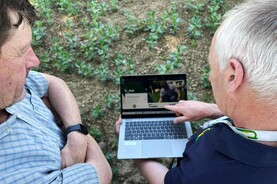Tillage operations play an important role in preparing the soil for planting and can initially enhance soil aeration and workability.
However, thoughtful management is essential to maintain long-term soil health.
Over time, repeated tilling may influence soil structure by accelerating the breakdown of organic matter and increasing susceptibility to erosion. This can gradually affect soil carbon levels, fertility, water retention and microbial diversity.
Additionally, consistent tillage at the same depth can sometimes result in a compacted layer, known as a ‘plough pan,’ which may limit water infiltration and root development, ultimately hindering crop growth.
In the absence of available organic manure amendments, cover crops can contribute to the remediation of some of the negative impacts of arable farming operations.
Cover crops provide a canopy and stabilise a living root system, to protect the soil from degradation over the winter period.
Surplus nutrients
These crops are also referred to as catch crops, as they help recover surplus available nutrients in the soil solution that may otherwise be lost through leaching or runoff over the winter period.
They also contribute to soil organic matter, through the release of root exudates and, following their destruction, through their residues integrating back into the soil.
This, in turn, supplies food for soil macro and micro fauna. Some deep-rooting cover crops may also contribute to the remediation of subsurface compaction in tillage systems.
However, selecting the right crop species for the required job, that is consistent with the crop rotation on the farm, and sowing it at the right time, is critical.
What you will see at the soil stand at Crops and Technology
At Crops and Technology, you can visit a walk-in soil pit, dug through a compacted tramline, to analyse the profile of a continuous tillage soil.Alongside the pit will be a range of cover crops, sown thissSpring, to demonstrate the different rooting depths and densities of root material of each of the crops as they grow through the soil. Some of the crops on display include linseed, forage rape, Phacelia and Mustard.What will you see in the soil walk-in pit?
Learn how to recognise soil compaction.Examine the effect of continuous traffic on a soil.Examine the impact of subsurface compaction on crop production. Compare and contrast different cover crops with different rooting structures that are available on the Irish market.Talk through what you see with soil researcher Dr Guilia Bondi and soil specialist adviser Dr Veronica Nyhan.
Tillage operations play an important role in preparing the soil for planting and can initially enhance soil aeration and workability.
However, thoughtful management is essential to maintain long-term soil health.
Over time, repeated tilling may influence soil structure by accelerating the breakdown of organic matter and increasing susceptibility to erosion. This can gradually affect soil carbon levels, fertility, water retention and microbial diversity.
Additionally, consistent tillage at the same depth can sometimes result in a compacted layer, known as a ‘plough pan,’ which may limit water infiltration and root development, ultimately hindering crop growth.
In the absence of available organic manure amendments, cover crops can contribute to the remediation of some of the negative impacts of arable farming operations.
Cover crops provide a canopy and stabilise a living root system, to protect the soil from degradation over the winter period.
Surplus nutrients
These crops are also referred to as catch crops, as they help recover surplus available nutrients in the soil solution that may otherwise be lost through leaching or runoff over the winter period.
They also contribute to soil organic matter, through the release of root exudates and, following their destruction, through their residues integrating back into the soil.
This, in turn, supplies food for soil macro and micro fauna. Some deep-rooting cover crops may also contribute to the remediation of subsurface compaction in tillage systems.
However, selecting the right crop species for the required job, that is consistent with the crop rotation on the farm, and sowing it at the right time, is critical.
What you will see at the soil stand at Crops and Technology
At Crops and Technology, you can visit a walk-in soil pit, dug through a compacted tramline, to analyse the profile of a continuous tillage soil.Alongside the pit will be a range of cover crops, sown thissSpring, to demonstrate the different rooting depths and densities of root material of each of the crops as they grow through the soil. Some of the crops on display include linseed, forage rape, Phacelia and Mustard.What will you see in the soil walk-in pit?
Learn how to recognise soil compaction.Examine the effect of continuous traffic on a soil.Examine the impact of subsurface compaction on crop production. Compare and contrast different cover crops with different rooting structures that are available on the Irish market.Talk through what you see with soil researcher Dr Guilia Bondi and soil specialist adviser Dr Veronica Nyhan. 





 This is a subscriber-only article
This is a subscriber-only article










SHARING OPTIONS: